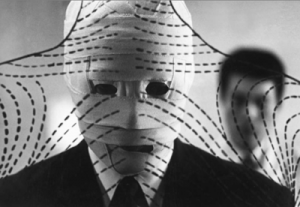The Face of Another isn’t director Hiroshi Teshigahara’s greatest film–that’s Woman in the Dunes–but it may have more great things stuffed into it than any of his other works. Existential, grotesque and stunningly bizarre, the movie uses some of the best set design in the history of cinema to tell its story about a horribly scarred Japanese man who gets a new face–and a raft of new identity issues.
Okuyama (Tatsuya Nakadai) was horribly burned about his face in a work-related fire and hides his angry visage behind a mummy’s roll of bandages. His appearance makes society and even his own wife recoil, and he wishes he could become invisible. But his unorthodox psychiatrist (Mikijiro Hira) has an idea: He will meticulously design a mask for Okuyama and the injured man will have a fresh beginning. The mask is ultimately incredibly lifelike and the burned man is able to pass in society, but Okuyama is bothered by looking like a third person that isn’t his old self or even the scarred one. And the shrink is something of a Doctor Frankenstein, caring more for his creation than his patient’s well-being.
The director is asking a host of questions about identity and whether all knowledge–even self-knowledge–is more relational than inherent. Some of the probing is trite, but there are numerous thorny questions to digest long after the film is over, especially in a world where people routinely alter their appearance with plastic surgery and face transplants actually exist. But what makes the movie incredible is the way Teshigahara utilizes design to communicate. For instance, the doctor’s office (which is the work of architect Arata Isozaki) is a mixture of baroque and modernist touches that speaks directly to the outré world Okuyama has walked into. And the psychiatrist who works in that office is less a doctor than an artist obsessed with the way the mind works–much like Teshigahara himself. (Available from Netflix and other outlets.)
More Film posts:
- New DVD: Greenberg.
- Strange, Small & Forgotten Films: The Silent Partner. (1978)
- New DVD: Big Man Japan.
- Classic DVDs: Symbiopsychotaxiplasm Take One. (1968)
- Strange, Small & Forgotten Films: Hi, Mom! (1970)
- Classic DVD: Beat the Devil. (1953)
- Strange, Small & Forgotten Films: Targets. (1968)
- New DVD: Crazy Heart.
- Strange, Small & Forgotten Films: All the Vermeers in New York. (1989)
- Classic DVD: “La Jetée.” (1962)
- New DVD: The T.A.M.I. Show.
- Strange, Small & Forgotten Films: Bad Company (1972)
- New DVD: The Maid.
- Classic DVD: The Other (1972).
- New DVD: Shutter Island.
- Strange, Small & Forgotten Films: The Naked Kiss (1964).
- Strange, Small & Forgotten Films: “La Soufriere” (1976).
- New DVD: The Road.
- Classic DVD: Network (1976).
- Top 20 Films of the Aughts.
- Classic DVD: Seconds (1966).
- New DVD: Art & Copy.
- Strange, Small & Forgotten Films: The Honeymoon Killers (1970).
- New DVD: Bad Lieutenant: Port of Call New Orleans.
- Strange, Small & Forgotten Films: Electra Glide in Blue (1973).
- Strange, Small & Forgotten Films: Prime Cut (1972).

